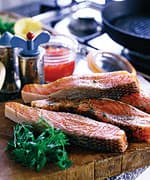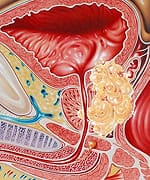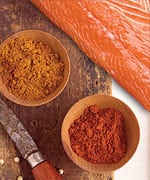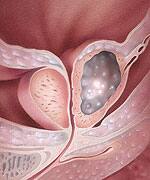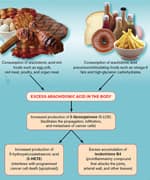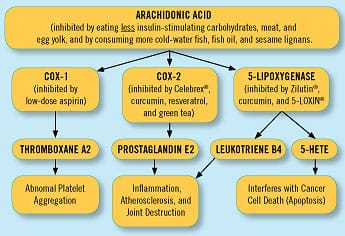Life Extension Magazine®
Cancer cells lurk in the prostate glands of most aging men, yet only one in six men is ever diagnosed with prostate cancer.1 If one looks at what is required for a single cancer cell to develop into a detectable tumor, it becomes obvious that natural barriers exist to protect people against full-blown cancer. Unfortunately, the dietary choices of most men living in the modern Western world circumvent the body’s natural protective barriers. The end result is that we unwittingly provide biological fuel for existing prostate cancer cells to propagate and metastasize. Good news: If you understand the biological roles of diet and specific nutrients, you’ll be able to achieve a considerable amount of control over whether isolated cancer cells in your prostate gland will ever show up as a clinically diagnosed disease. So keep reading, because what you learn here can make a difference between bad news and good news in your future. The impact of the food we ingest on cell growth and death is so pronounced that it can be identical to the effects displayed by anti-cancer drugs. Unlike synthetic drugs, however, the proper dietary constituents produce no side effects and confer additional health benefits.
All cancers begin when genes that regulate cellular proliferation become so damaged that they can no longer control normal cell division. For example, scientists are actively engaged in clinical research using selenium because it helps protect specific genes that enable cells to divide normally.2-5 The limitation of a nutrient like selenium, however, is that it may not be able to reverse accumulated damage (mutations) to such cell-regulating genes. Prostate cell genes are especially prone to mutations early in the course of human life. This has been demonstrated by autopsy findings of prostate cancer cells in younger men who never knew they had the disease.6 Doctors continue to wonder why so many men with active cancer cells in their prostate glands do not progress to overt disease. One answer may relate to the discovery of a particular enzyme that prostate cancer cells use to propagate, infiltrate, and metastasize. A large volume of published research indicates that this enzyme functions via multiple pathological pathways to facilitate prostate cancer at various stages.7-21 The encouraging news is that this enzyme can be suppressed via dietary modification and the use of dietary supplements, many of which are already being utilized by health-conscious men today. Omega 3 Fatty Acids: The First Line of DefenseDiets high in omega-6 fats and saturated fats are associated with greater prostate cancer risk, whereas increased intake of omega-3 fats from fish has been shown to reduce risk.22-29 Based on consistent epidemiological findings across a wide range of human populations, scientists have sought to understand why eating the wrong kinds of fat (saturated and omega-6 fats) provokes a stimulatory effect on prostate cancer.
To ascertain what happens after we eat bad fats, all one has to do is look at the metabolic breakdown pathways that these fats follow in the body, as shown in the chart on the right (Figure 1). For example, let us assume that for dinner, you eat a steak (a source of saturated fat) and a salad, along with a typical salad dressing of soybean and/or safflower oils (sources of omega-6 fats). As can be seen in Figure 1, both saturated and omega-6 fats convert to arachidonic acid in the body, whereas the meat itself contains arachidonic acid. One way that the body rids itself of excess arachidonic acid is by producing a dangerous enzyme called 5-lipoxygenase (5-LOX). New studies show conclusively that 5-LOX directly stimulates prostate cancer cell proliferation via several well-defined mechanisms.2,26,30-36 In addition, arachidonic acid is metabolized by 5-LOX to 5-HETE, a potent survival factor that prostate cancer cells utilize to escape destruction.31,37-40 Figure 1 clearly demonstrates how consuming a diet of foods rich in arachidonic acid directly provokes the production of the dangerous 5-LOX enzyme, which can promote the progression of prostate cancer. In addition to 5-HETE, 5-LOX also metabolizes arachidonic acid to leukotriene B4, a potent pro-inflammatory agent that causes destructive reactions throughout the body and inflicts severe damage to the arterial wall.41-47 One reason that fish oil supplements have become so popular is that their beneficial EPA/DHA fatty acids can help reduce production of arachidonic acid in the body. As shown in Figure 1, if arachidonic acid levels are reduced, there would be a corresponding suppression of 5-LOX, 5-HETE, and leukotriene B4.
Once one understands the lethal 5-lipoxygenase (5-LOX) cascades, it is easy to see why people who excessively consume foods rich in arachidonic acid, and those who do not reduce the production of excessive arachidonic acid metabolites, are setting themselves up for prostate cancer and a host of inflammatory diseases (including atherosclerosis).2,30,35,48,49 5-LOX Is Over-expressed in Prostate CancerBased on studies showing that consumption of foods rich in arachidonic acid is greatest in regions with high incidences of prostate cancer,26,30,35,49 scientists sought to determine how much of the 5-LOX enzyme is present in malignant versus benign prostate tissues. Using biopsy samples taken from living human patients, the researchers found that 5-LOX levels were an astounding six-fold greater in malignant prostate tissues compared to benign tissues. This study also found that levels of 5-HETE (a 5-LOX metabolite that prevents prostate cancer destruction) were 2.2-fold greater in malignant versus benign prostate tissues.33 The scientists concluded this study by stating that selective inhibitors of 5-LOX may be useful in the prevention or treatment of patients with prostate cancer.
5-LOX Promotes Tumor Growth FactorsAs the evidence mounts that ingesting “bad fats” increases prostate cancer risk, scientists are evaluating the effects of 5-LOX on various growth factors involved in the progression, angiogenesis, and metastasis of cancer cells. One study found that 5-LOX activity is required to stimulate prostate cancer cell growth by epidermal growth factor (EGF) and other cancer cell proliferating factors produced in the body. When 5-LOX levels were reduced, the cancer cell stimulatory effect of EGF and other growth factors was diminished.30 In a mouse study, an increase in 5-LOX resulted in a corresponding increase in vascular endothelial growth factor (VEGF), a key growth factor that tumor cells use to stimulate new blood vessel formation (angiogenesis) into the tumor. 5-LOX inhibitors were shown to reduce tumor angiogenesis along with a host of other growth factors.50 In both androgen-dependent and androgen-independent human prostate cancer cell lines, the inhibition of 5-lipoxygenase (5-LOX) has consistently been shown to induce rapid and massive apoptosis (cancer cell destruction).26,49,51-54 Nutrients That Suppress 5-LOXHealth-conscious people already take nutrients like fish oil that help to lower 5-LOX activity in the body.20,21 Studies show that lycopene and saw palmetto extract also help to suppress 5-LOX.51,55-68 The suppression of 5-LOX by these nutrients may partially account for their favorable effects on the prostate gland. As humans age, however, chronic inflammatory processes can cause the over-expression of 5-LOX in the body. For maturing males, the result of excess 5-LOX may be the epidemic of prostate cancer observed after the age of 60. Based on the cumulative knowledge that 5-LOX can promote the invasion and metastasis of prostate cancer cells, it would appear advantageous to take aggressive steps to suppress this lethal enzyme. The good news is that a natural 5-lipoxygenase (5-LOX) inhibitor is now available and has been added to a popular formula used to maintain healthy prostate function. In addition to potentially suppressing prostate cancer, the successful inhibition of 5-LOX should also slow the progression of atherosclerosis.
| ||||||||||||||||||||||
5-LOXIN®: Nature’s 5-LOX InhibitorSpecific extracts from the Boswellia plant selectively inhibit 5-lipoxygenase (5-LOX).69,70 This is not surprising when one considers that various boswellia extracts have been used for centuries in India as anti-inflammatory agents.71 In several well-controlled human studies, boswellia has been shown to be effective in alleviating various chronic inflammatory disorders.72-82 Scientists have discovered that the specific constituent in boswellia responsible for suppressing 5-LOX is AKBA (3-O-acetyl-11-keto-B-boswellic acid). Boswellia-derived AKBA binds directly to 5-LOX and inhibits its activity.70 Other boswellic acids only partially and incompletely inhibit 5-LOX.70,83 Methods to extract high concentrations of AKBA from boswellia have been intensively investigated due to AKBA’s potential in treating chronic inflammatory disorders. Even in standardized boswellia extracts, however, biologically active AKBA makes up only 2-5% of the final product. Several years ago, researchers discovered how to obtain an economically viable boswellia extract standardized to contain a greater than 30% concentration of AKBA. This 30% AKBA extraction discovery was patented and given the trademark name “5-LOXIN®. When tested against the best commercial boswellia compounds, 5-LOXIN® exhibited better inhibitory action against 5-LOX.
5-LOXIN® Decreases Inflammation, Invasive Potential, Tumor Cell Adhesiveness, and AngiogenesisA rat study was conducted to evaluate the efficacy of 5-LOXIN® compared to the popular anti-inflammatory drug ibuprofen. 5-LOXIN® reduced inflammation by 27%, compared to 35% for ibuprofen.84 Another rat study compared 5-LOXIN® to the anti-inflammatory steroid drug prednisone. 5-LOXIN® reduced inflammation by 55%, which was similar to the prednisone used in the study.79,85 The significance of these findings is that prednisone and ibuprofen can be toxic when used chronically, whereas natural 5-LOXIN® is free of side effects. Ibuprofen has demonstrated anti-cancer effects, most probably due to its inhibition of cyclooxygenase-2 (COX-2), another enzyme that cancer cells use to facilitate their growth and survival. As you have just learned, 5-LOXIN® functions to block the 5-LOX enzyme. Since the effects of 5-LOXIN® and ibuprofen may be either additive or synergistic, a clinical trial of a combination of these agents is warranted.
Tumor necrosis factor-alpha (TNF-α) is a dangerous pro-inflammatory cytokine that often increases in aging people. In a gene-chip study, 5-LOXIN® blocked the expression of many genes that are sensitive to the pathological effects of TNF-α.84 From the standpoint of keeping prostate cancer cells in check, 5-LOXIN® was shown to prevent the TNF-α-induced expression of a protein-degrading enzyme called matrix metalloproteinase (MMP). Cancer cells use the MMP enzyme to tear apart natural barriers in the body that would normally encase them. Prostate cancer cells are notorious for inducing the production of this enzyme that causes containment structures within the prostate gland to vanish, thus enabling the mutated (cancerous) prostate cells to break through healthy prostate tissue and eventually metastasize.86 Prostate cancer cells use adhesion molecules (known as VCAM-1 and ICAM-1) to facilitate their spread throughout the body. 5-LOXIN® was shown to prevent the up-regulation of these adhesion molecules, which are directly involved in inflammatory processes.85 Chronic inflammation is tightly linked to the induction of aberrant angiogenesis used by cancer cells to facilitate the growth of new blood vessels (angiogenesis) into tumors.87
ConclusionA plethora of research documents the role of chronic inflammatory mediators such as 5-lipooxygenase (5-LOX) and tumor necrosis factor-alpha (TNF-α) in the manifestation and progression of prostate and other cancers.7-19,30,31,33,49,52-54,87,88 The typical American diet is high in omega-6 fatty acids, saturated fats, and arachidonic acid. Over-consumption of these foods, and under-consumption of omega-3 fatty acids, contribute significantly to systemic chronic inflammatory states. Boswellia extracts have been thoroughly studied as natural remedies for inflammatory disorders. A patented extract from boswellia called 5-LOXIN® has potent ability to inhibit the enzyme 5-LOX, preventing the formation of protein-degrading enzymes, and protecting against inflammation-induced events that can promote tumor angiogenesis.
| |||||||||
| References | |||||||||
| 1. Available at: http://www.cancer.org/docroot/CRI/content/CRI_2_4_1X_What_are_the_key_statistics_for_prostate_cancer_36.asp?sitearea=. Accessed September 11, 2006. 2. Ghosh J. Rapid induction of apoptosis in prostate cancer cells by selenium: reversal by metabolites of arachidonate 5-lipoxygenase. Biochem Biophys Res Commun. 2004 Mar 12;315(3):624-35. 3. Vogt TM, Ziegler RG, Graubard BI, et al. Serum selenium and risk of prostate cancer in U.S. blacks and whites. Int J Cancer. 2003 Feb 20;103(5):664-70. 4. Yoshizawa K, Willett WC, Morris SJ, et al. Study of prediagnostic selenium level in toenails and the risk of advanced prostate cancer. J Natl Cancer Inst. 1998 Aug 19;90(16):1219-24. 5. Clark LC, Combs GF, Jr., Turnbull BW, et al. Effects of selenium supplementation for cancer prevention in patients with carcinoma of the skin. A randomized controlled trial. Nutritional Prevention of Cancer Study Group. JAMA. 1996 Dec 25;276(24):1957-63. 6. Sakr WA, Haas GP, Cassin BF, Pontes JE, Crissman JD. The frequency of carcinoma and intraepithelial neoplasia of the prostate in young male patients. J Urol. 1993 Aug;150(2 Pt 1):379-85. 7. Claria J, Romano M. Pharmacological intervention of cyclooxygenase-2 and 5-lipoxygenase pathways. Impact on inflammation and cancer. Curr Pharm Des. 2005;11(26):3431-47. 8. Radmark O. 5-lipoxygenase-derived leukotrienes: mediators also of atherosclerotic inflammation. Arterioscler Thromb Vasc Biol. 2003 Jul 1;23(7):1140-2. 9. Xu XC. COX-2 inhibitors in cancer treatment and prevention, a recent development. Anticancer Drugs. 2002 Feb;13(2):127-37. 10. Nie D, Che M, Grignon D, Tang K, Honn KV. Role of eicosanoids in prostate cancer progression. Cancer Metastasis Rev. 2001;20(3-4):195-206. 11. Steele VE, Holmes CA, Hawk ET, et al. Lipoxygenase inhibitors as potential cancer chemopreventives. Cancer Epidemiol Biomarkers Prev. 1999 May;8(5):467-83. 12. Vahlensieck W, Jr., Fabricius PG, Hell U. Drug therapy of benign prostatic hyperplasia. Fortschr Med. 1996 Nov 10;114(31):407-11. 13. Moore RJ, Owens DM, Stamp G, et al. Mice deficient in tumor necrosis factor-alpha are resistant to skin carcinogenesis. Nat Med. 1999 Jul;5(7):828-31. 14. Suganuma M, Okabe S, Sueoka E, et al. A new process of cancer prevention mediated through inhibition of tumor necrosis factor alpha expression. Cancer Res. 1996 Aug 15;56(16):3711-5. 15. Wu S, Boyer CM, Whitaker RS, et al. Tumor necrosis factor alpha as an autocrine and paracrine growth factor for ovarian cancer: monokine induction of tumor cell proliferation and tumor necrosis factor alpha expression. Cancer Res. 1993 Apr 15;53(8):1939-44. 16. Orosz P, Echtenacher B, Falk W, et al. Enhancement of experimental metastasis by tumor necrosis factor. J Exp Med. 1993 May 1;177(5):1391-8. 17. Ammon HP, Safayhi H, Mack T, Sabieraj J. Mechanism of antiinflammatory actions of curcumine and boswellic acids. J Ethnopharmacol. 1993 Mar;38(2-3):113-9. 18. Ammon HP, Mack T, Singh GB, Safayhi H. Inhibition of leukotriene B4 formation in rat peritoneal neutrophils by an ethanolic extract of the gum resin exudate of Boswellia serrata. Planta Med. 1991 Jun;57(3):203-7. 19. Gelin J, Moldawer LL, Lonnroth C, et al. Role of endogenous tumor necrosis factor alpha and interleukin 1 for experimental tumor growth and the development of cancer cachexia. Cancer Res. 1991 Jan 1;51(1):415-21. 20. Taccone-Gallucci M, Manca-di-Villahermosa S, Battistini L, et al. N-3 PUFAs reduce oxidative stress in ESRD patients on maintenance HD by inhibiting 5-lipoxygenase activity. Kidney Int. 2006 Apr;69(8):1450-4. 21. Calder PC. N-3 polyunsaturated fatty acids and inflammation: from molecular biology to the clinic. Lipids. 2003 Apr;38(4):343-52. 22. Christensen JH, Fabrin K, Borup K, Barber N, Poulsen J. Prostate tissue and leukocyte levels of n-3 polyunsaturated fatty acids in men with benign prostate hyperplasia or prostate cancer. BJU Int. 2006 Feb;97(2):270-3. 23. Kelavkar UP, Hutzley J, Dhir R, et al. Prostate tumor growth and recurrence can be modulated by the omega-6:omega-3 ratio in diet: athymic mouse xenograft model simulating radical prostatectomy. Neoplasia. 2006 Feb;8(2):112-24. 24. Kelavkar U, Lin Y, Landsittel D, Chandran U, Dhir R. The yin and yang of 15-lipoxygenase-1 and delta-desaturases: Dietary omega-6 linoleic acid metabolic pathway in prostate. J Carcinog. 2006 Mar 27;5:9. 25. Astorg P. Dietary fatty acids and colorectal and prostate cancers: epidemiological studies. Bull Cancer. 2005 Jul;92(7):670-84. 26. Moretti RM, Montagnani MM, Sala A, Motta M, Limonta P. Activation of the orphan nuclear receptor RORalpha counteracts the proliferative effect of fatty acids on prostate cancer cells: crucial role of 5-lipoxygenase. Int J Cancer. 2004 Oct 20;112(1):87-93. 27. Augustsson K, Michaud DS, Rimm EB, et al. A prospective study of intake of fish and marine fatty acids and prostate cancer. Cancer Epidemiol Biomarkers Prev. 2003 Jan;12(1):64-7. 28. Hughes-Fulford M, Chen Y, Tjandrawinata RR. Fatty acid regulates gene expression and growth of human prostate cancer PC-3 cells. Carcinogenesis. 2001 May;22(5):701-7. 29. Newcomer LM, King IB, Wicklund KG, Stanford JL. The association of fatty acids with prostate cancer risk. Prostate. 2001 Jun 1;47(4):262-8. 30. Hassan S, Carraway RE. Involvement of arachidonic acid metabolism and EGF receptor in neurotensin-induced prostate cancer PC3 cell growth. Regul Pept. 2006 Jan 15;133(1-3):105-14. 31. Matsuyama M, Yoshimura R, Mitsuhashi M, et al. Expression of lipoxygenase in human prostate cancer and growth reduction by its inhibitors. Int J Oncol. 2004 Apr;24(4):821-7. 32. Kelavkar UP, Glasgow W, Olson SJ, Foster BA, Shappell SB. Overexpression of 12/15-lipoxygenase, an ortholog of human 15-lipoxygenase-1, in the prostate tumors of TRAMP mice. Neoplasia. 2004 Nov;6(6):821-30. 33. Gupta S, Srivastava M, Ahmad N, et al. Lipoxygenase-5 is overexpressed in prostate adenocarcinoma. Cancer. 2001 Feb 15;91(4):737-43. 34. Kelavkar UP, Nixon JB, Cohen C, et al. Overexpression of 15-lipoxygenase-1 in PC-3 human prostate cancer cells increases tumorigenesis. Carcinogenesis. 2001 Nov;22(11):1765-73. 35. Ghosh J, Myers CE. Arachidonic acid stimulates prostate cancer cell growth: critical role of 5-lipoxygenase. Biochem Biophys Res Commun. 1997 Jun 18;235(2):418-23. 36. Gao X, Grignon DJ, Chbihi T, et al. Elevated 12-lipoxygenase mRNA expression correlates with advanced stage and poor differentiation of human prostate cancer. Urology. 1995 Aug;46(2):227-37. 37. Sundaram S, Ghosh J. Expression of 5-oxoETE receptor in prostate cancer cells: critical role in survival. Biochem Biophys Res Commun. 2006 Jan 6;339(1):93-8. 38. Myers CE, Ghosh J. Lipoxygenase inhibition in prostate cancer. Eur Urol. 1999;35(5-6):395-8. 39. Nakao-Hayashi J, Ito H, Kanayasu T, Morita I, Murota S. Stimulatory effects of insulin and insulin-like growth factor I on migration and tube formation by vascular endothelial cells. Atherosclerosis. 1992 Feb;92(2-3):141-9. 40. Cohen P, Peehl DM, Lamson G, Rosenfeld RG. Insulin-like growth factors (IGFs), IGF receptors, and IGF-binding proteins in primary cultures of prostate epithelial cells. J Clin Endocrinol Metab. 1991 Aug;73(2):401-7. 41. Helgadottir A, Manolescu A, Thorleifsson G, et al. The gene encoding 5-lipoxygenase activating protein confers risk of myocardial infarction and stroke. Nat Genet. 2004 Mar;36(3):233-9. 42. Poff CD, Balazy M. Drugs that target lipoxygenases and leukotrienes as emerging therapies for asthma and cancer. Curr Drug Targets Inflamm Allergy. 2004 Mar;3(1):19-33. 43. Crooks SW, Bayley DL, Hill SL, Stockley RA. Bronchial inflammation in acute bacterial exacerbations of chronic bronchitis: the role of leukotriene B4. Eur Respir J. 2000 Feb;15(2):274-80. 44. Tabata T, Ono S, Song C, et al. Role of leukotriene B4 in monocrotaline-induced pulmonary hypertension. Nihon Kyobu Shikkan Gakkai Zasshi. 1997 Feb;35(2):160-6. 45. Gadaleta D, Fantini GA, Silane MF, Davis JM. Neutrophil leukotriene generation and pulmonary dysfunction after abdominal aortic aneurysm repair. Surgery. 1994 Nov;116(5):847-52. 46. Shindo K, Miyakawa K, Fukumura M. Plasma levels of leukotriene B4 in asthmatic patients. Int J Tissue React. 1993;15(5):181-4. 47. Mullane K, Hatala MA, Kraemer R, Sessa W, Westlin W. Myocardial salvage induced by REV-5901: an inhibitor and antagonist of the leukotrienes. J Cardiovasc Pharmacol. 1987 Oct;10(4):398-406. 48. De CR, Zampolli A. From asthma to atherosclerosis—5-lipoxygenase, leukotrienes, and inflammation. N Engl J Med. 2004 Jan 1;350(1):4-7. 49. Ghosh J. Inhibition of arachidonate 5-lipoxygenase triggers prostate cancer cell death through rapid activation of c-Jun N-terminal kinase. Biochem Biophys Res Commun. 2003 Jul 25;307(2):342-9. 50. Ye YN, Liu ES, Shin VY, Wu WK, Cho CH. Contributory role of 5-lipoxygenase and its association with angiogenesis in the promotion of inflammation-associated colonic tumorigenesis by cigarette smoking. Toxicology. 2004 Oct 15;203(1-3):179-88. 51. Hazai E, Bikadi Z, Zsila F, Lockwood SF. Molecular modeling of the non-covalent binding of the dietary tomato carotenoids lycopene and lycophyll, and selected oxidative metabolites with 5-lipoxygenase. Bioorg Med Chem. 2006 Oct 15;14(20):6859-67. 52. Ghosh J, Myers CE. Inhibition of arachidonate 5-lipoxygenase triggers massive apoptosis in human prostate cancer cells. Proc Natl Acad Sci USA. 1998 Oct 27;95(22):13182-7. 53. Yang P, Collin P, Madden T, et al. Inhibition of proliferation of PC3 cells by the branched-chain fatty acid, 12-methyltetradecanoic acid, is associated with inhibition of 5-lipoxygenase. Prostate. 2003 Jun 1;55(4):281-91. 54. Anderson KM, Seed T, Vos M, et al. 5-Lipoxygenase inhibitors reduce PC-3 cell proliferation and initiate nonnecrotic cell death. Prostate. 1998 Nov 1;37(3):161-73. 55. Jian L, Du CJ, Lee AH, Binns CW. Do dietary lycopene and other carotenoids protect against prostate cancer? Int J Cancer. 2005 Mar 1;113(6):1010-4. 56. Campbell JK, Canene-Adams K, Lindshield BL, et al. Tomato phytochemicals and prostate cancer risk. J Nutr. 2004 Dec;134(12 Suppl):3486S-92S. 57. Wertz K, Siler U, Goralczyk R. Lycopene: modes of action to promote prostate health. Arch Biochem Biophys. 2004 Oct 1;430(1):127-34. 58. Binns CW, LJ LJ, Lee AH. The relationship between dietary carotenoids and prostate cancer risk in Southeast Chinese men. Asia Pac J Clin Nutr. 2004;13(Suppl):S117. 59. Kim L, Rao AV, Rao LG. Effect of lycopene on prostate LNCaP cancer cells in culture. J Med Food. 2002;5(4):181-7. 60. Giovannucci E. A review of epidemiologic studies of tomatoes, lycopene, and prostate cancer. Exp Biol Med (Maywood.). 2002 Nov;227(10):852-9. 61. Vogt TM, Mayne ST, Graubard BI, et al. Serum lycopene, other serum carotenoids, and risk of prostate cancer in US blacks and whites. Am J Epidemiol. 2002 Jun 1;155(11):1023-32. 62. Bosetti C, Tzonou A, Lagiou P, et al. Fraction of prostate cancer incidence attributed to diet in Athens, Greece. Eur J Cancer Prev. 2000 Apr;9(2):119-23. 63. Blumenfeld AJ, Fleshner N, Casselman B, Trachtenberg J. Nutritional aspects of prostate cancer: a review. Can J Urol. 2000 Feb;7(1):927-35. 64. Agarwal S, Rao AV. Tomato lycopene and its role in human health and chronic diseases. CMAJ. 2000 Sep 19;163(6):739-44. 65. Gann PH, Ma J, Giovannucci E, et al. Lower prostate cancer risk in men with elevated plasma lycopene levels: results of a prospective analysis. Cancer Res. 1999 Mar 15;59(6):1225-30. 66. Giovannucci E, Ascherio A, Rimm EB, et al. Intake of carotenoids and retinol in relation to risk of prostate cancer. J Natl Cancer Inst. 1995 Dec 6;87(23):1767-76. 67. Hill B, Kyprianou N. Effect of permixon on human prostate cell growth: lack of apoptotic action. Prostate. 2004 Sep 15;61(1):73-80. 68. Paubert-Braquet M, Mencia Huerta JM, Cousse H, Braquet P. Effect of the lipidic lipidosterolic extract of Serenoa repens (Permixon) on the ionophore A23187-stimulated production of leukotriene B4 (LTB4) from human polymorphonuclear neutrophils. Prostaglandins Leukot Essent Fatty Acids. 1997 Sep;57(3):299-304. 69. Safayhi H, Rall B, Sailer ER, Ammon HP. Inhibition by boswellic acids of human leukocyte elastase. J Pharmacol Exp Ther. 1997 Apr;281(1):460-3. 70. Safayhi H, Sailer ER, Ammon HP. Mechanism of 5-lipoxygenase inhibition by acetyl-11-keto-beta-boswellic acid. Mol Pharmacol. 1995 Jun;47(6):1212-6. 71. Basch E, Boon H, vies-Heerema T, et al. Boswellia: an evidence-based systematic review by the Natural Standard Research Collaboration. J Herb Pharmacother. 2004;4(3):63-83. 72. Kimmatkar N, Thawani V, Hingorani L, Khiyani R. Efficacy and tolerability of Boswellia serrata extract in treatment of osteoarthritis of knee—a randomized double blind placebo controlled trial. Phytomedicine. 2003 Jan;10(1):3-7. 73. Ammon HP. Boswellic acids (components of frankincense) as the active principle in treatment of chronic inflammatory disease. Wien Med Wochenschr. 2002;152(15-16):373-8. 74. Wallace JM. Nutritional and botanical modulation of the inflammatory cascade--eicosanoids, cyclooxygenases, and lipoxygenases—as an adjunct in cancer therapy. Integr Cancer Ther. 2002 Mar;1(1):7-37. 75. Gupta I, Parihar A, Malhotra P, et al. Effects of gum resin of Boswellia serrata in patients with chronic colitis. Planta Med. 2001 Jul;67(5):391-5. 76. Gerhardt H, Seifert F, Buvari P, Vogelsang H, Repges R. Therapy of active Crohn disease with Boswellia serrata extract H 15. Z Gastroenterol. 2001 Jan;39(1):11-7. 77. Gupta I, Gupta V, Parihar A, et al. Effects of Boswellia serrata gum resin in patients with bronchial asthma: results of a double-blind, placebo-controlled, 6-week clinical study. Eur J Med Res. 1998 Nov 17;3(11):511-4. 78. Kulkarni RR, Patki PS, Jog VP, Gandage SG, Patwardhan B. Treatment of osteoarthritis with a herbomineral formulation: a double-blind, placebo-controlled, cross-over study. J Ethnopharmacol. 1991 May;33(1-2):91-5. 79. Available at: http://www.plthomas.com/PLTbrands/5-Loxin%20Fact%20Sheet%209-05.pdf. Accessed September 12, 2006. 80. Park YS, Lee JH, Harwalkar JA, et al. Acetyl-11-keto-beta-boswellic acid (AKBA) is cytotoxic for meningioma cells and inhibits phosphorylation of the extracellular-signal regulated kinase 1 and 2. Adv Exp Med Biol. 2002;507:387-93. 81. Liu JJ, Nilsson A, Oredsson S, Badmaev V, Duan RD. Keto- and acetyl-keto-boswellic acids inhibit proliferation and induce apoptosis in Hep G2 cells via a caspase-8 dependent pathway. Int J Mol Med. 2002 Oct;10(4):501-5. 82. Syrovets T, Buchele B, Gedig E, Slupsky JR, Simmet T. Acetyl-boswellic acids are novel catalytic inhibitors of human topoisomerases I and IIalpha. Mol Pharmacol. 2000 Jul;58(1):71-81. 83. Sailer ER, Subramanian LR, Rall B, et al. Acetyl-11-keto-beta-boswellic acid (AKBA): structure requirements for binding and 5-lipoxygenase inhibitory activity. Br J Pharmacol. 1996 Feb;117(4):615-8. 84. Roy S, Khanna S, Shah H, et al. Human genome screen to identify the genetic basis of the anti-inflammatory effects of Boswellia in microvascular endothelial cells. DNA Cell Biol. 2005 Apr;24(4):244-55. 85. Roy S, Khanna S, Krishnaraju AV, et al. Regulation of vascular responses to inflammation: inducible matrix metalloproteinase-3 expression in human microvascular endothelial cells is sensitive to antiinflammatory Boswellia. Antioxid Redox Signal. 2006 Mar;8(3-4):653-60. 86. Katiyar SK. Matrix metalloproteinases in cancer metastasis: molecular targets for prostate cancer prevention by green tea polyphenols and grape seed proanthocyanidins. Endocr Metab Immune Disord Drug Targets. 2006 Mar;6(1):17-24. 87. Rajashekhar G, Willuweit A, Patterson CE, et al. Continuous endothelial cell activation increases angiogenesis: evidence for the direct role of endothelium linking angiogenesis and inflammation. J Vasc Res. 2006;43(2):193-204. 88. Aggarwal BB, Shishodia S, Sandur SK, Pandey MK, Sethi G. Inflammation and cancer: How hot is the link? Biochem Pharmacol. 2006 Nov 30;72(11):1605-21. 89. Jiang WG, Douglas-Jones AG, Mansel RE. Aberrant expression of 5-lipoxygenase-activating protein (5-LOXAP) has prognostic and survival significance in patients with breast cancer. Prostaglandins Leukot Essent Fatty Acids. 2006 Feb;74(2):125-34. 90. Yoshimura R, Matsuyama M, Mitsuhashi M, et al. Relationship between lipoxygenase and human testicular cancer. Int J Mol Med. 2004 Mar;13(3):389-93. 91. Zhang L, Zhang WP, Hu H, et al. Expression patterns of 5-lipoxygenase in human brain with traumatic injury and astrocytoma. Neuropathology. 2006 Apr;26(2):99-106. 92. Soumaoro LT, Iida S, Uetake H, et al. Expression of 5-Lipoxygenase in human colorectal cancer. World J Gastroenterol. 2006 Oct 21;12(39):6355-60. 93. Hayashi T, Nishiyama K, Shirahama T. Inhibition of 5-lipoxygenase pathway suppresses the growth of bladder cancer cells. Int J Urol. 2006 Aug;13(8):1086-91. 94. Matsuyama M, Yoshimura R, Tsuchida K, et al. Lipoxygenase inhibitors prevent urological cancer cell growth. Int J Mol Med. 2004 May;13(5):665-8. 95. Hoque A, Lippman SM, Wu TT, et al. Increased 5-lipoxygenase expression and induction of apoptosis by its inhibitors in esophageal cancer: a potential target for prevention. Carcinogenesis. 2005 Apr;26(4):785-91. 96. Hennig R, Ding XZ, Tong WG, et al. 5-Lipoxygenase and leukotriene B(4) receptor are expressed in human pancreatic cancers but not in pancreatic ducts in normal tissue. Am J Pathol. 2002 Aug;161(2):421-8. 97. Ding XZ, Iversen P, Cluck MW, Knezetic JA, Adrian TE. Lipoxygenase inhibitors abolish proliferation of human pancreatic cancer cells. Biochem Biophys Res Commun. 1999 Jul 22;261(1):218-23. 98. Matsuyama M, Yoshimura R, Mitsuhashi M, et al. 5-Lipoxygenase inhibitors attenuate growth of human renal cell carcinoma and induce apoptosis through arachidonic acid pathway. Oncol Rep. 2005 Jul;14(1):73-9. 99. Zhi H, Zhang J, Hu G, et al. The deregulation of arachidonic acid metabolism-related genes in human esophageal squamous cell carcinoma. Int J Cancer. 2003 Sep 1;106(3):327-33. 100. Penglis PS, Cleland LG, Demasi M, Caughey GE, James MJ. Differential regulation of prostaglandin E2 and thromboxane A2 production in human monocytes: implications for the use of cyclooxygenase inhibitors. J Immunol. 2000 Aug 1;165(3):1605-11. 101. Rubinsztajn R, Wronska J, Chazan R. [Urinary leukotriene E4 concentration in patients with bronchial asthma and intolerance of non-steroids anti-inflammatory drugs before and after oral aspirin challenge]. Pol Arch Med Wewn. 2003 Aug;110(2):849-854. 102. Subbarao K, Jala VR, Mathis S, et al. Role of leukotriene B4 receptors in the development of atherosclerosis: potential mechanisms. Arterioscler Thromb Vasc Biol. 2004 Feb;24(2):369-75. 103. Laufer S. Role of eicosanoids in structural degradation in osteoarthritis. Curr Opin Rheumatol. 2003 Sep;15(5):623-7. 104. de L, X, Hanson J, David JL, et al. New developments on thromboxane and prostacyclin modulators part II: prostacyclin modulators. Curr Med Chem. 2004 May;11(10):1243-52. 105. Cheng Y, Austin SC, Rocca B, et al. Role of prostacyclin in the cardiovascular response to thromboxane A2. Science. 2002 Apr 19;296(5567):539-41. 106. Catella-Lawson F. Vascular biology of thrombosis: platelet-vessel wall interactions and aspirin effects. Neurology. 2001;57(5 Suppl 2):S5-S7. 107. James MJ, Penglis PS, Caughey GE, Demasi M, Cleland LG. Eicosanoid production by human monocytes: does COX-2 contribute to a self-limiting inflammatory response? Inflamm Res. 2001 May;50(5):249-53. 108. Garcia Rodriguez LA. The effect of NSAIDs on the risk of coronary heart disease: fusion of clinical pharmacology and pharmacoepidemiologic data. Clin Exp Rheumatol. 2001 Nov;19(6 Suppl 25):S41-4. 109. Nie D, Lamberti M, Zacharek A, et al. Thromboxane A(2) regulation of endothelial cell migration, angiogenesis, and tumor metastasis. Biochem Biophys Res Commun. 2000 Jan 7;267(1):245-51. 110. Pommery N, Taverne T, Telliez A, et al. New COX-2/5-LOX inhibitors: apoptosis-inducing agents potentially useful in prostate cancer chemotherapy. J Med Chem. 2004 Dec 2;47(25):6195-206. 111. Onguru O, Casey MB, Kajita S, Nakamura N, Lloyd RV. Cyclooxygenase-2 and thromboxane synthase in non-endocrine and endocrine tumors: a review. Endocr Pathol. 2005;16(4):253-77. 112. Mutoh M, Takahashi M, Wakabayashi K. Roles of prostanoids in colon carcinogenesis and their potential targeting for cancer chemoprevention. Curr Pharm Des. 2006;12(19):2375-82. 113. Wang D, Dubois RN. Prostaglandins and cancer. Gut. 2006 Jan;55(1):115-22. 114. Wang D, Wang H, Shi Q, et al. Prostaglandin E(2) promotes colorectal adenoma growth via transactivation of the nuclear peroxisome proliferator-activated receptor delta. Cancer Cell. 2004 Sep;6(3):285-95. 115. Paramo JA, Beloqui O, Orbe J. Cyclooxygenase-2: a new therapeutic target in atherosclerosis? Med Clin (Barc.). 2006 May 27;126(20):782-6. 116. Feldman M, Cryer B, Rushin K, Betancourt J. A comparison of every-third-day versus daily low-dose aspirin therapy on serum thromboxane concentrations in healthy men and women. Clin Appl Thromb Hemost. 2001 Jan;7(1):53-7. 117. Sciulli MG, Renda G, Capone ML, et al. Heterogeneity in the suppression of platelet cyclooxygenase-1 activity by aspirin in coronary heart disease. Clin Pharmacol Ther. 2006 Aug;80(2):115-25. 118. Eidelman RS, Hebert PR, Weisman SM, Hennekens CH. An update on aspirin in the primary prevention of cardiovascular disease. Arch Intern Med. 2003 Sep 22;163(17):2006-10. 119. Berger JS, Roncaglioni MC, Avanzini F, et al. Aspirin for the primary prevention of cardiovascular events in women and men: a sex-specific meta-analysis of randomized controlled trials. JAMA. 2006 Jan 18;295(3):306-13. 120. Zhang F, Altorki NK, Mestre JR, Subbaramaiah K, Dannenberg AJ. Curcumin inhibits cyclooxygenase-2 transcription in bile acid- and phorbol ester-treated human gastrointestinal epithelial cells. Carcinogenesis. 1999 Mar;20(3):445-51. 121. Bengmark S. Curcumin, an atoxic antioxidant and natural NFkappaB, cyclooxygenase-2, lipooxygenase, and inducible nitric oxide synthase inhibitor: a shield against acute and chronic diseases. JPEN J Parenter Enteral Nutr. 2006 Jan;30(1):45-51. 122. Shah BH, Nawaz Z, Pertani SA, et al. Inhibitory effect of curcumin, a food spice from turmeric, on platelet-activating factor- and arachidonic acid-mediated platelet aggregation through inhibition of thromboxane formation and Ca2+ signaling. Biochem Pharmacol. 1999 Oct 1;58(7):1167-72. 123. Lantz RC, Chen GJ, Solyom AM, Jolad SD, Timmermann BN. The effect of turmeric extracts on inflammatory mediator production. Phytomedicine. 2005 Jun;12(6-7):445-52. 124. Lev-Ari S, Maimon Y, Strier L, Kazanov D, Arber N. Down-regulation of prostaglandin E2 by curcumin is correlated with inhibition of cell growth and induction of apoptosis in human colon carcinoma cell lines. J Soc Integr Oncol. 2006;4(1):21-6. 125. Chauhan DP. Chemotherapeutic potential of curcumin for colorectal cancer. Curr Pharm Des. 2002;8(19):1695-706. 126. Lev-Ari S, Strier L, Kazanov D, et al. Celecoxib and curcumin synergistically inhibit the growth of colorectal cancer cells. Clin Cancer Res. 2005 Sep 15;11(18):6738-44. 127. Park C, Kim GY, Kim GD, et al. Induction of G2/M arrest and inhibition of cyclooxygenase-2 activity by curcumin in human bladder cancer T24 cells. Oncol Rep. 2006 May;15(5):1225-31. 128. Hong J, Bose M, Ju J, et al. Modulation of arachidonic acid metabolism by curcumin and related beta-diketone derivatives: effects on cytosolic phospholipase A(2), cyclooxygenases and 5-lipoxygenase. Carcinogenesis. 2004 Sep;25(9):1671-9. 129. Yoysungnoen P, Wirachwong P, Bhattarakosol P, Niimi H, Patumraj S. Effects of curcumin on tumor angiogenesis and biomarkers, COX-2 and VEGF, in hepatocellular carcinoma cell-implanted nude mice. Clin Hemorheol Microcirc. 2006;34(1-2):109-15. 130. Lev-Ari S, Zinger H, Kazanov D, et al. Curcumin synergistically potentiates the growth inhibitory and pro-apoptotic effects of celecoxib in pancreatic adenocarcinoma cells. Biomed Pharmacother. 2005 Oct;59 Suppl 2S276-80. 131. Tunstall RG, Sharma RA, Perkins S, et al. Cyclooxygenase-2 expression and oxidative DNA adducts in murine intestinal adenomas: modification by dietary curcumin and implications for clinical trials. Eur J Cancer. 2006 Feb;42(3):415-21. 132. Lee J, Im YH, Jung HH, et al. Curcumin inhibits interferon-alpha induced NF-kappaB and COX-2 in human A549 non-small cell lung cancer cells. Biochem Biophys Res Commun. 2005 Aug 26;334(2):313-8. 133. Hong J, Smith TJ, Ho CT, August DA, Yang CS. Effects of purified green and black tea polyphenols on cyclooxygenase- and lipoxygenase-dependent metabolism of arachidonic acid in human colon mucosa and colon tumor tissues. Biochem Pharmacol. 2001 Nov 1;62(9):1175-83. 134. Noreen Y, Ringbom T, Perera P, Danielson H, Bohlin L. Development of a radiochemical cyclooxygenase-1 and -2 in vitro assay for identification of natural products as inhibitors of prostaglandin biosynthesis. J Nat Prod. 1998 Jan;61(1):2-7. 135. Ahmed S, Rahman A, Hasnain A, et al. Green tea polyphenol epigallocatechin-3-gallate inhibits the IL-1 beta-induced activity and expression of cyclooxygenase-2 and nitric oxide synthase-2 in human chondrocytes. Free Radic Biol Med. 2002 Oct 15;33(8):1097-105. 136. Subbaramaiah K, Michaluart P, Chung WJ, et al. Resveratrol inhibits cyclooxygenase-2 transcription in human mammary epithelial cells. Ann NY Acad Sci. 1999;889:214-23. 137. Bhat KP, Pezzuto JM. Cancer chemopreventive activity of resveratrol. Ann NY Acad Sci. 2002 May;957:210-29. 138.Szewczuk LM, Penning TM. Mechanism-based inactivation of COX-1 by red wine m-hydroquinones: a structure-activity relationship study. J Nat Prod. 2004 Nov;67(11):1777-82. 139. Available at: http://www.bmj.com/cgi/content/full/329/7470/816-a. Accessed November 17, 2006. 140. Solomon SD, Pfeffer MA, McMurray JJ, et al. Effect of celecoxib on cardiovascular events and blood pressure in two trials for the prevention of colorectal adenomas. Circulation. 2006 Sep 5;114(10):1028-35. 141. St Sauver JL, Jacobson DJ, McGree ME, Lieber MM, Jacobsen SJ. Protective association between nonsteroidal antiinflammatory drug use and measures of benign prostatic hyperplasia. Am J Epidemiol. 2006 Oct 15;164(8):760-8. |

